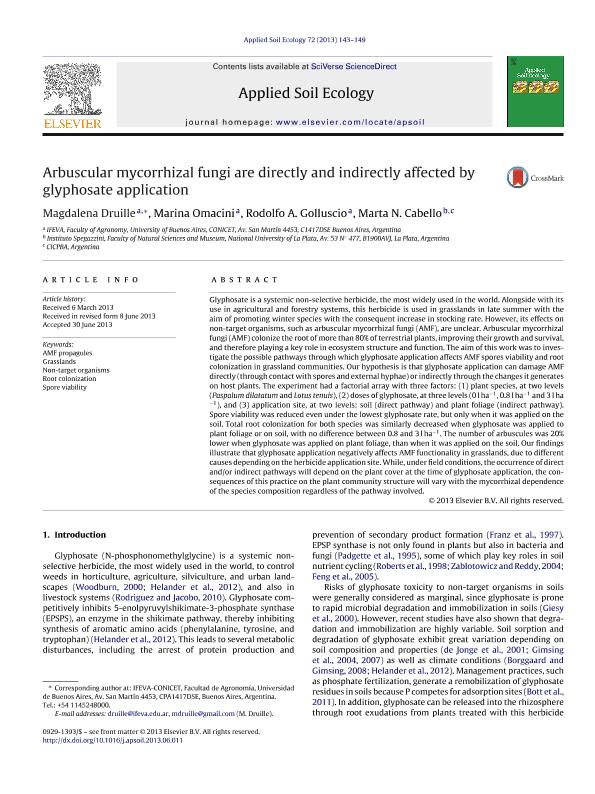Mostrar el registro sencillo del ítem
dc.contributor.author
Druille, Magdalena

dc.contributor.author
Omacini, Marina

dc.contributor.author
Golluscio, Rodolfo

dc.contributor.author
Cabello, Marta Noemi
dc.date.available
2016-02-12T19:10:51Z
dc.date.issued
2013-06
dc.identifier.citation
Druille, Magdalena; Omacini, Marina; Golluscio, Rodolfo; Cabello, Marta Noemi; Arbuscular mycorrhizal fungi are directly and indirectly affected byglyphosate application; Elsevier; Applied Soil Ecology; 72; 6-2013; 143-149
dc.identifier.issn
0929-1393
dc.identifier.uri
http://hdl.handle.net/11336/4187
dc.description.abstract
Glyphosate is a systemic non-selective herbicide, the most widely used in the world. Alongside with itsuse in agricultural and forestry systems, this herbicide is used in grasslands in late summer with theaim of promoting winter species with the consequent increase in stocking rate. However, its effects onnon-target organisms, such as arbuscular mycorrhizal fungi (AMF), are unclear. Arbuscular mycorrhizalfungi (AMF) colonize the root of more than 80% of terrestrial plants, improving their growth and survival,and therefore playing a key role in ecosystem structure and function. The aim of this work was to inves-tigate the possible pathways through which glyphosate application affects AMF spores viability and rootcolonization in grassland communities. Our hypothesis is that glyphosate application can damage AMFdirectly (through contact with spores and external hyphae) or indirectly through the changes it generateson host plants. The experiment had a factorial array with three factors: (1) plant species, at two levels(Paspalum dilatatum and Lotus tenuis), (2) doses of glyphosate, at three levels (0 l ha−1, 0.8 l ha−1and 3 l ha−1), and (3) application site, at two levels: soil (direct pathway) and plant foliage (indirect pathway).Spore viability was reduced even under the lowest glyphosate rate, but only when it was applied on thesoil. Total root colonization for both species was similarly decreased when glyphosate was applied toplant foliage or on soil, with no difference between 0.8 and 3 l ha−1. The number of arbuscules was 20%lower when glyphosate was applied on plant foliage, than when it was applied on the soil. Our findingsillustrate that glyphosate application negatively affects AMF functionality in grasslands, due to differentcauses depending on the herbicide application site. While, under field conditions, the occurrence of directand/or indirect pathways will depend on the plant cover at the time of glyphosate application, the con-sequences of this practice on the plant community structure will vary with the mycorrhizal dependenceof the species composition regardless of the pathway involved.
dc.format
application/pdf
dc.language.iso
eng
dc.publisher
Elsevier

dc.rights
info:eu-repo/semantics/openAccess
dc.rights.uri
https://creativecommons.org/licenses/by-nc-nd/2.5/ar/
dc.subject
Amf Propagules
dc.subject
Grasslands
dc.subject
Non-Target Organisms
dc.subject
Root Colonization
dc.subject.classification
Micología

dc.subject.classification
Ciencias Biológicas

dc.subject.classification
CIENCIAS NATURALES Y EXACTAS

dc.subject.classification
Agronomía, reproducción y protección de plantas

dc.subject.classification
Agricultura, Silvicultura y Pesca

dc.subject.classification
CIENCIAS AGRÍCOLAS

dc.title
Arbuscular mycorrhizal fungi are directly and indirectly affected byglyphosate application
dc.type
info:eu-repo/semantics/article
dc.type
info:ar-repo/semantics/artículo
dc.type
info:eu-repo/semantics/publishedVersion
dc.date.updated
2016-03-30 10:35:44.97925-03
dc.journal.volume
72
dc.journal.pagination
143-149
dc.journal.pais
Países Bajos

dc.journal.ciudad
Amsterdam
dc.description.fil
Fil: Druille, Magdalena. Consejo Nacional de Investigaciones Científicas y Técnicas. Oficina de Coordinación Administrativa Parque Centenario. Instituto de Investigaciones Fisiológicas y Ecológicas Vinculadas a la Agricultura; Argentina
dc.description.fil
Fil: Omacini, Marina. Consejo Nacional de Investigaciones Científicas y Técnicas. Oficina de Coordinación Administrativa Parque Centenario. Instituto de Investigaciones Fisiológicas y Ecológicas Vinculadas a la Agricultura; Argentina
dc.description.fil
Fil: Golluscio, Rodolfo. Consejo Nacional de Investigaciones Científicas y Técnicas. Oficina de Coordinación Administrativa Parque Centenario. Instituto de Investigaciones Fisiológicas y Ecológicas Vinculadas a la Agricultura; Argentina
dc.description.fil
Fil: Cabello, Marta Noemi. Universidad Nacional de la Plata. Facultad de Ciencias Naturales y Museo. Instituto de Botánica Spegazzini; Argentina. Provincia de Buenos Aires. Gobernación. Comisión de Investigaciones Científicas; Argentina
dc.journal.title
Applied Soil Ecology

dc.relation.alternativeid
info:eu-repo/semantics/altIdentifier/doi/http://dx.doi.org/10.1016/j.apsoil.2013.06.011
dc.relation.alternativeid
info:eu-repo/semantics/altIdentifier/issn/0929-1393
dc.relation.alternativeid
info:eu-repo/semantics/altIdentifier/url/http://www.sciencedirect.com/science/article/pii/S0929139313001868
Archivos asociados
